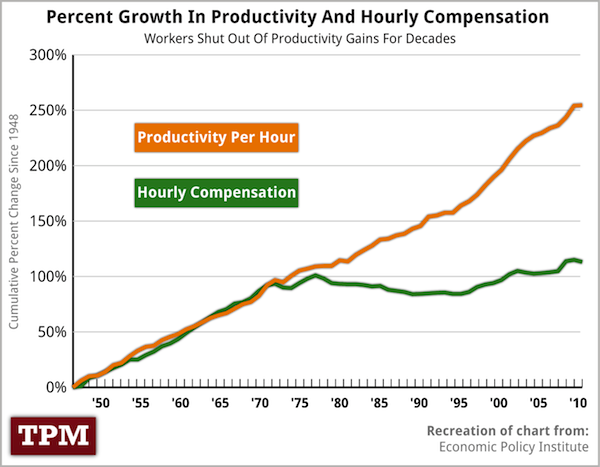Insights · May 15th, 2012
Recently when addressing a Chamber of Commerce event I risked raising the issue of what I call “income gap economics” in the U.S. This is a risk because in my experience the business community can tend to assume that you are about to attack success and wealth. But I received a very positive response, as I do among all audiences, when I explained this situation more clearly.
There is no historical or mathematical question that from about the end of World War II until about 1979 all segments of the U.S. economic population saw their incomes grow at about the same rate, more than doubling in real dollars. It was a time of the greatest emergence of a middle class that we’ve ever seen, so far. Recently a new piece of research by the Economic Policy Institute produced a chart that more clearly than anything that I have seen explains a key reason that income went up for everyone in that time period. The chart matches productivity gains and wages. Here it is.

What we see is that from 1950 to about 1970 wage growth perfectly tracked productivity growth. Produce more, get paid more. This relationship began to slip in the early 1970’s and then split dramatically beginning about 1980. Produce more, get paid the same. That became the new reality.
At that point, at first we did not notice the divergence. A shift from one-income to two-income families masked the deteriorating situation for wage earners. Later it was easy credit card debt, then sky rocketing home equity that provided an appearance of affluence when the underlying connection of productivity to wages continued to deteriorate. Then, as I often say, what could not be sustained was not sustained.
Wealth did grow, due to the dramatic increases in productivity. But this increased wealth did not go into increased wages, as had been the case historically.
The challenge I am putting to audiences is simple. In order to have a healthy national economy we have to find ways to reconnect improvements in productivity to increased wages across the board, no matter what the rest of the world is doing. This will not be simple to do. But that is the mission – reconnect wages to productivity growth and get the income of those below the top 10% growing again. Without that, there really can be no long term healthy economy.
Glen Hiemstra is a futurist, author, speaker, consultant, Founder of Futurist.com, and founder and Curator of DoTheFuture.com. To arrange for a speech, workshop or consultation contact Futurist.com.

